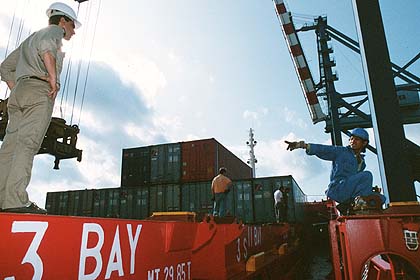News
The movement of cargo in containers in Latin American and Caribbean ports grew 1.7% during 2015, according to figures unveiled in ECLAC’s new edition of its ranking of container port throughput, published in its Maritime Profile,. These figures confirm two trends observed during the last years in the region: the slowdown of foreign trade shown by container terminals and great heterogeneity of the growth rates inside the region.
Regional average of 1.7% container throughput growth, although still higher than the rate recorded in 2014 (0.8%) and 2013 (0.7%), the recovery from this severe downturn remains (figures from 2012 were 5.9%). The slow dynamism of 2015 was determined mainly by the fall in the port activity of five countries: Brazil, Peru, Puerto Rico, Trinidad & Tobago and Venezuela. The total volume of activity in 2015 was approximately 48 million TEU. The first 40 ports in the ranking accounted for nearly 90% of the operations this type of cargo in the region, while another 98 smaller ports divided up the remaining 5.9 million TEU (equivalent to 10%) among themselves.
The figures reveal great heterogeneity in the performance of port movements, both at a subregional level as well as by country. In 2015, ECSA’s activity reduction reached 1.4%, this especially considering the lower expansion of throughput in Brazilian ports, where the port movements fell by 2.1% compared to the previous year. WCSA results suggest a slight increase in container throughput, with a positive variation of 1.1%. The stagnation of the container ports in Chile (0.1%) and the negative variation of Peruvian ports (-3.6%) counterbalances the growth rate in Ecuador (6.3%) and the Port of Buenaventura in the Pacific Coast of Colombia (6.6%). Central America dropped 0.1% reaching 3.4% last year versus a growth of 3.5% in 2014, whilst the throughput figures of the Caribbean ports remained flat with only +0.1% change.
At a country level, six countries stood out: Colombia (13.1%), Nicaragua (24.4%), Barbados (10.3%), St. Vincent and the Grenadines (11.3%), Monserrat (11.7%), and Anguilla (27.7%), while other six countries from the region have showed an important slowdown in their activity: Argentina (-0.3%), Brazil (-2.1%), Peru (-3.6%), Puerto Rico (-8.3%), Trinidad & Tobago (-12.4%),and Venezuela (-22.2%). Mexico increased its port activity considering the 3.8% figure of 2014 to.7.4% in 2015. In Central America, the reduced growth of Panamanian ports during 2015 hides and important rise in the port activity of some countries of the sub-region. Throughput increased in El Salvador (6.4%), Guatemala (6.9%), Honduras (8.9%) and Nicaragua (24.4%).
At an individual level, the ports that registered a relatively better performance during 2015 were: Santos (3,645,448 TEU), Colón (3,577,427 TEU), Balboa (3,294,113 TEU), Cartagena (2,606,945 TEU), Manzanillo (2,458,135 TEU), El Callao (1,900,444 TEU), Guayaquil (1,764,937 TEU), Kingston (1,653,272 TEU), Buenos Aires (1,433,053 TEU) and Freeport (1,400,000 TEU). See Table:”Latin American and the Caribbean Container Port Throughput, Ranking 2015”in annex for details. Just as in previous periods, the reasons behind growth, deceleration or an outright decrease in port activity are varied. For example, the ports of Cartagena 16.6% (Colombia), Colón 8.8% (Panama), Guayaquil 8.9% (Ecuador), Manzanillo 4.4% (Mexico), Veracruz 9.9% (Mexico), and San Antonio 7.0% (Chile) registered positive figures due to the success of their projects and commercial management, while others were affected by low trade performance in general as in the case of El Callao -4.6% (Peru), Puerto Cabello -19.2% (Venezuela), Valparaíso -10.7% (Chile), San Juan -8.8% (Puerto Rico), Río de Janeiro -28.0% (Brazil) and Balboa -5.0% (Panama).
On a global scale, during 2015, the containers traffic in ports also had a low dynamism. The global container throughput grew by only 1.1% in 2015, according to Alphaliner’s estimates based on a preliminary survey of over 400 ports worldwide. Last year’s global throughput growth logged the second lowest annual growth rate ever recorded for the industry, surpassed only by the record low of 2009 when it declined by -8.4% due to the global financial crisis.
In relation to the causes, several factors have contributed to the lower container throughput growth in recent years, including[1]: the impact of the technological change of conversion from breakbulk to a containerized mode of transportation has plateaued; increased share of manufactured goods versus raw materials transported by containers, and a corresponding trend of miniaturization of manufactured goods; the rate of offshoring of manufactured activities to Asia and especially to China has slowed; changes in the imbalances of trade: the decelerated growth of laden container volumes in one direction leads to the lower volume of container goods, as well as to the reduced empty container handling; reduced incidence of container transshipment, as more ports are served directly. Various ports in Southeast Asia, Latin America or Africa that were previously connected mainly by feeder or relay services have attracted mainline calls as volumes increased while port facilities have been improved.
[1]Alphaliner Weekly Review, Volume 2016 Issue 08


